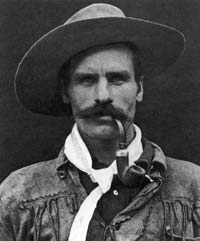
Bill Peyto (courtesy Whyte Museum archives)
Bill Peyto
(1868-1943) After arriving in Canada from England in 1886, Peyto worked for the CPR, homesteaded, and prospected before entering the outfitting business with Tom Wilson. When he was chosen to lead Edward Whymper to Vermilion Pass he had acquired a solid reputation for his work with Walter Wilcox, Norman Collie, and others. Walter Wilcox wrote of Bill Peyto, "Bill is very quiet in civilization, but becomes more communicative around an evening campfire, when he delights to tell his adventures. His life has been a roving life. The story of his battle with the world, his escapades and sufferings of hunger and exposure not to mention the dreams and ambitions of a keen imagination with their consequent disappointments, has served to entertain many an evening hour. Peyto assumes a wild and picturesque though somewhat tattered attire. A sombrero, with a rakish tilt to one side, a blue shirt set off by a white kerchief (which may have served civilization for napkin), and a buckskin coat with a fringe border, add to his cowboy appearance. A heavy belt containing a row of cartridges, hunting-knife, and six-shooter as well as the restless activity of his wicked blue eyes, give him an air of bravado. He usually wears two pairs of trousers, one over the other, the outer pair about six months older. This was shown by their dilapidated and faded state, hanging, after a week of rough work in burnt timer, in a tattered fringe knee-high. Every once in a while Peyto would give one or two nervous yanks at the fringe and tear off the longer pieces, so that his outer trousers disappeared day by day from below upwards. Part of this was affection, to impress the tender foot, or the 'dude,' as he calls everyone who wears a collar. But in spite of this Peyto is one of the most conscientious and experience men with horses that I have ever known." Bill and Edward Whymper seemed to get along reasonably well during their initial trip together and although he found numerous faults with his Swiss guides, he felt that Peyto had, "properly executed his commission." Later in the summer however, after a severe tongue-lashing from Whymper for coming back to camp to early from trail clearing work in the Yoho Valley, Bill walked out on him with the excuse that he had to take two sick horses back to Field. Following his wife's death in 1906, Bill gave up the outfitting business and worked as a trapper and prospector. In 1913 he became one of Banff park's first wardens. After service with the armed forces during World War I during which he was wounded in action, he returned to the mountains and the warden service. In 1921 he participated in the rescue of Margaret Stone, who had been trapped for several days on the lower cliffs of Eon Mountain following the first ascent of the mountain. Peyto Lake, just to the north of Bow Pass, was named because of Bill's need to enjoy some privacy while travelling through the area. A regular campsite along the route between Lake Louise and the Saskatchewan River was at Bow Summit. It is said that Bill would sometimes spend the night by himself at the lake, remarking to others at the campsite that, "It's just too crowded around here for me." For this reason the lake became known as Peyto Lake. [See Trapper Peak; Peyto Peak]